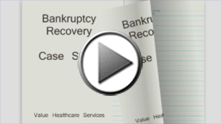CASE STUDY
“Over 80% of all Consumer Bankruptcies filed in the US are a result of Medical Bills.”
For many Healthcare facilities nationwide, patient bankruptcies are overlooked and written off as Bad Debt based on the assumption that they have no value. The following case study will prove that they are in fact worth quite a lot.
A second crucial finding of this case study deals with the way patient bankruptcies are handled Both collection agencies and lawyers claim to have the expertise to manage these unique patient accounts. However, in most cases, collection vendors do not have the necessary procedures in place to capture a vast majority of the revenue. What’s the solution? We’ll address that after the results of our study.
First a little background. In 2012, we travelled to over 100 hospitals and asked a simple question: What are your bankruptcies worth? Most of the responses were the same, they’re worth very little or even nothin’. That is contrary to our experience with non-healthcare related bankruptcy receivables. For 25 years, working with top Fortune 500 companies, we historically have seen recovery rates as high as 25%. So we initially set out to conduct a case study to see the real numbers and determine how much hospital revenue was being missed, the lost opportunity of Bankruptcy Recoveries. However, we learned something else very valuable from the hospitals we visited, most of them were not familiar with how the recovery process works. Properly tracking and filing claims in a timely manner is crucial. The case study clearly shows the need for a proactive strategy. That’s where Value Healthcare Services was born.
The Case Study
Here are the parameters of our hospital bankruptcy case study.
Target Location: One of the Largest Healthcare facilities located in the 3rd Federal District North Eastern region, with annual revenues greater than $8 Billion Dollars.
Cases Searched: We Randomly pulled 500 Chapter 13 Filings out of ~ 18,000 that occurred in the 3rd Federal District in 2012 or approximately 2.5%, in order to extrapolate the full picture.
The Simple Goal: To first determine how many bankruptcy petitions referenced the facility or had any Healthcare Debts stated on the Bankruptcy Filing. We then wanted to see how many Proof of Claims were filed on behalf of the Hospital.
The Results
Out of 500 random cases, 423 had no outstanding debts referencing the facility. 77 of the chapter 13 bankruptcy cases, with a total of $152,282 of Outstanding Debt, were directly related to the Hospital. All of this information was found using public files and without accessing any hospital records. Once we determined that there were 77 cases that pertained to the facility, we looked into each of them to see how many proofs of claims were filed on behalf of the hospital. Out of 77, we were shocked to find out that only 1 Proof of Claim, in the amount of $2,011, was filed on behalf of the Hospital. Only 1! This means that there were 76 cases totaling $150,271 where no Claims were filed on behalf of the Hospital.
We then confirmed the payout % (weighted average) declared by the Trustee on Unsecured Debt (Medical Debts are considered Unsecured) which was 8.91%.
Missed Opportunity
Let’s look closely at the numbers and what the “lost” revenue was for the Hospital.. The total amount of debt listed for the 76 cases that the hospital missed, was $150,271. The payout, determined by trustee, was just under 9%. So the hospital could have recovered an additional $13,391 versus the $179 which was recovered, if all of the proofs of claims were filed in a timely manner.
This case study was a tiny sample, or 2.5%, of all the Bankruptcies filed in the District. So if we extrapolate the full amount of lost opportunity for this one facility for all Bankruptcies in the district, the true lost opportunity is over $650,000. Additionally, the payout would have likely been significantly higher than ~9%. Let’s explain. The federally mandated process of bankruptcy involves a Trustee, who oversees the filing of claims by the creditors. The ~9% payout in our case is assuming that all Creditors file claims. That rarely happens, in part because creditors must file a claim in a timely manner. If they miss the window of opportunity they cannot collect any money. So, once that window expired, the 9% exponentially becomes higher as the pool of money is distributed to a smaller number of creditors. This is why historically our recoveries can reach as high as 25%. The case study clearly shows that Proofs of Claims were not being filed by the hospital. There are not second chances when it comes to bankruptcy filings.
Also, keep in mind that this case study only includes Chapter 13 filings and not Chapter 7 which account for ~ 70% of all Bankruptcies. Although Chapter 7 filings don’t produce the 20+% recoveries, they can be substantial due to the percentage of overall bankruptcies. Historically, Chapter 7 filings will recover 1/2% over time.
Lastly, This case study is only a sampling of the total population of bankruptcies in this federal district. Patients from surrounding Federal Districts likely have this facility’s debt listed in their petitions.
Conclusion
This random case study clearly proves two important points. First, that bankruptcies are worth a substantial amount of money if properly filed. Second, that facilities must implement a proactive strategy that is fully automated and able to catch bankruptcies before the window for filing closes forever.
Value Healthcare Services is designed to help hospitals create efficiencies in the collection of bankruptcy receivables. We guide our facilities through the entire process, from integration and monitoring to filing and recovery, with little internal resources needed from our clients.
How much are your bankruptcies worth? For a free evaluation and to request a similar case study in your hospital district, be in touch with our headquarters or email info@valuehealthcareservices.



